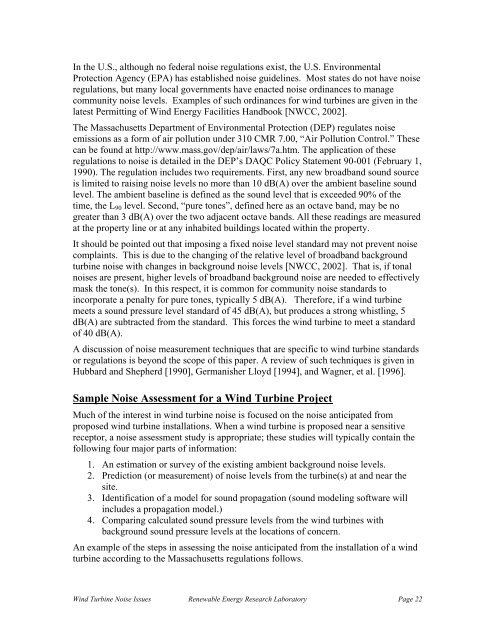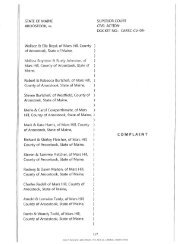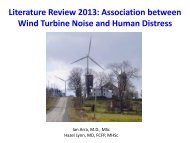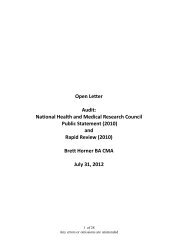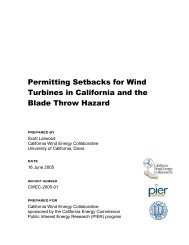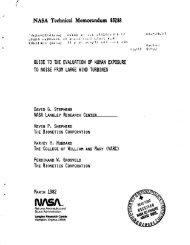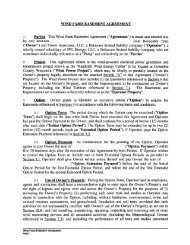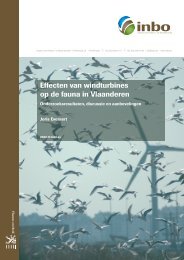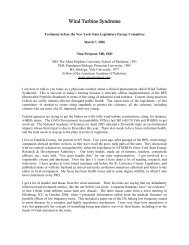Noise White Paper Outline - Minuteman Wind, LLC
Noise White Paper Outline - Minuteman Wind, LLC
Noise White Paper Outline - Minuteman Wind, LLC
Create successful ePaper yourself
Turn your PDF publications into a flip-book with our unique Google optimized e-Paper software.
In the U.S., although no federal noise regulations exist, the U.S. EnvironmentalProtection Agency (EPA) has established noise guidelines. Most states do not have noiseregulations, but many local governments have enacted noise ordinances to managecommunity noise levels. Examples of such ordinances for wind turbines are given in thelatest Permitting of <strong>Wind</strong> Energy Facilities Handbook [NWCC, 2002].The Massachusetts Department of Environmental Protection (DEP) regulates noiseemissions as a form of air pollution under 310 CMR 7.00, “Air Pollution Control.” Thesecan be found at http://www.mass.gov/dep/air/laws/7a.htm. The application of theseregulations to noise is detailed in the DEP’s DAQC Policy Statement 90-001 (February 1,1990). The regulation includes two requirements. First, any new broadband sound sourceis limited to raising noise levels no more than 10 dB(A) over the ambient baseline soundlevel. The ambient baseline is defined as the sound level that is exceeded 90% of thetime, the L 90 level. Second, “pure tones”, defined here as an octave band, may be nogreater than 3 dB(A) over the two adjacent octave bands. All these readings are measuredat the property line or at any inhabited buildings located within the property.It should be pointed out that imposing a fixed noise level standard may not prevent noisecomplaints. This is due to the changing of the relative level of broadband backgroundturbine noise with changes in background noise levels [NWCC, 2002]. That is, if tonalnoises are present, higher levels of broadband background noise are needed to effectivelymask the tone(s). In this respect, it is common for community noise standards toincorporate a penalty for pure tones, typically 5 dB(A). Therefore, if a wind turbinemeets a sound pressure level standard of 45 dB(A), but produces a strong whistling, 5dB(A) are subtracted from the standard. This forces the wind turbine to meet a standardof 40 dB(A).A discussion of noise measurement techniques that are specific to wind turbine standardsor regulations is beyond the scope of this paper. A review of such techniques is given inHubbard and Shepherd [1990], Germanisher Lloyd [1994], and Wagner, et al. [1996].Sample <strong>Noise</strong> Assessment for a <strong>Wind</strong> Turbine ProjectMuch of the interest in wind turbine noise is focused on the noise anticipated fromproposed wind turbine installations. When a wind turbine is proposed near a sensitivereceptor, a noise assessment study is appropriate; these studies will typically contain thefollowing four major parts of information:1. An estimation or survey of the existing ambient background noise levels.2. Prediction (or measurement) of noise levels from the turbine(s) at and near thesite.3. Identification of a model for sound propagation (sound modeling software willincludes a propagation model.)4. Comparing calculated sound pressure levels from the wind turbines withbackground sound pressure levels at the locations of concern.An example of the steps in assessing the noise anticipated from the installation of a windturbine according to the Massachusetts regulations follows.<strong>Wind</strong> Turbine <strong>Noise</strong> Issues Renewable Energy Research Laboratory Page 22


